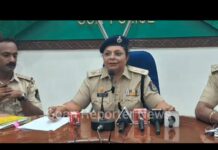Panaji, May 21, 2018 … Several states in India have witnessed unprecedented high temperatures in the recent past, leading to heat strokes and heat-related deaths; the elderly and children are particularly more susceptible.
A heat stroke is a form of hyperthermia or heat-related illness caused by long exposure to high environmental temperature. It can be caused by intense physical activity in hot weather, exposure to a hot environment for prolonged periods, excessive physical activity in hot weather, not drinking enough water in hot weather and due to wearing excessive clothing in hot weather. Alcohol consumption causing an imbalance in temperature maintenance is also one of the major causes of Heat strokes.
Newborns and infants, children, elderly, individuals who work in direct sunlight for hours. eg. Laborers, farmers, road and construction workers etc. and those who engage in rigorous physical activity including sports eg. Athletes, Military personnel, Police are more often prone to heat stroke.
Heat stroke occurs most commonly during the summer months of April to July. The key sign of heat stroke is a body temperature above 104 Degree Fahrenheit (40 Degree Celsius) and consumed state of mind. Throbbing headache, dizziness and light-headedness, lack of sweating despite the heat, red, hot, and dry skin, muscle weakness or cramps, nausea and vomiting, extreme lethargy, rapid heartbeat, rapid shallow breathing, mental confusion, disorientation, unsteadiness of gait or staggering, seizures and unconsciousness are the some of the signs of heat strokes.
To prevent heat stroke public need to take appropriate measures. If someone has a heat stroke, arrangements should be made to take the person immediately to the nearest health facility. One can also initiate First aid measure immediately and educate the family/community about the same.
A person with heat stroke must be moved to an open and well-ventilated environment or a cool, shady area, remove any unnecessary clothing, aim to reduce the temperature to less than 101 degrees Fahrenheit. Use a fan over the patient while wetting his or her skin with water using a sponge or towel and apply ice packs, if available, to the patient’s armpits, groin, neck, and back. If possible, immerse the patient in a shower or tub of cool water, or an ice bath. Do not apply an ice pack or immense newborn/baby in water as it may cause hypothermia.
However, there are several ways in which one can prevent Heat Stroke. Wear lightweight, light-colored and loose-fitting clothing, keep the house well ventilated, especially the cooking area, keep the doors and windows open. During the hottest part of the day, cover the windows with curtains, cloth, bed sheet etc. To prevent dehydration, drink at least eight glasses of water, fruit juice, buttermilk or other fluids daily. Avoid vigorous physical activities in hot and humid weather. Where possible, avoid going out during the hottest period of the day i.e. early and late afternoons. Take additional precautions when working outdoors in the field or exercising. Drink water/juice etc even not thirsty. Houses with tin roofs tend to get hotter. Take extra precautions in such a case. Avoid alcohol during this time.
Babies who are exclusively breastfed may need extra breast-feeds in hot weather. Children above 6 months of age, who have started complementary feeding, can be given small amounts of cool, boiled water between feeds. Choose the coolest place in the house for babies or young children to sleep. Give young children (over 6 months of age) regular fluids throughout the day. Children should be prevented from playing outside in sun during peak hours of the day.





